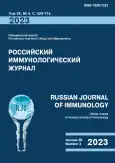Analysis of regulatory T lymphocytes in patients with traumatic brain injury
- Authors: Norka A.O.1,2, Vorobyev S.V.3, Kuznetsova R.N.1,2, Serebriakova M.K.4, Kudryavtsev I.V.1,5, Kovalenko S.N.4, Monashenko D.N.6
-
Affiliations:
- First St. Petersburg State I. Pavlov Medical University
- Saint Petersburg Pasteur Institute
- V. Almazov National Medical Research Centre
- S. Kirov Military Medical Academy
- Institute of Experimental Medicine
- St. Petersburg City Hospital No. 26, St. Petersburg
- Issue: Vol 26, No 4 (2023)
- Pages: 587-592
- Section: Forum Sochi 2023
- URL: https://journals.rcsi.science/1028-7221/article/view/253446
- DOI: https://doi.org/10.46235/1028-7221-13981-AOR
- ID: 253446
Cite item
Full Text
Abstract
In recent years, traumatic brain injury (TBI) has been one of the most urgent medical and social problems due to its prevalence, predominantly affecting young people of working age, causing high mortality, disability and economic costs for treatment and subsequent rehabilitation of patients. At present, the role of patients’ immune system in evolving neuroinflammation after traumatic brain injury has been proven. Treg cell populations represent an important factor determining the outcome of the disease due to promoting induction of immunological tolerance, being a significant component of immunoregulation. As a result of our study, we found a decrease in the relative content of Treg within the total lymphocyte pool of peripheral blood, which has the CD3+CD4+CD25bright phenotype in patients of the 3rd and 4th groups, in comparison with the data from control group. Moreover, a decreased relative content of Tregs (CD4+CD25+T cells) was revealed which is due to the degree of brain tissue damage and, as a result, their migration to suppress inflammation due to production of anti-inflammatory cytokines (TGF-â, IL-10). The Treg population is heterogeneous, thus prompting us for analysis of the Treg subpopulations profile based on the expression of CD45R0 and CD62L. When assessing subpopulations of regulatory T lymphocytes within CD45Ro and CD62L, significant changes were found only in patients with brain contusion. The changes were revealed within the pool of “naive” T regulatory lymphocytes with the CD3+CD4+CD25brightCD39+ Treg phenotype, capable of producing a wide range of cytokines specific for Th1, Th2, Th17, in patients with mild, moderate and severe TBI. Meanwhile, the level of highly active CD3+CD4+CD25brightCD73+ Tregs was significantly reduced in patients with moderate and severe TBI. These changes indicate an imbalance in immunoregulatory processes resulting from extensive damage to brain tissues.
Full Text
##article.viewOnOriginalSite##About the authors
Anna O. Norka
First St. Petersburg State I. Pavlov Medical University; Saint Petersburg Pasteur Institute
Email: norka-anna@mail.ru
Senior Laboratory Assistant, Department of Immunology, First St. Petersburg State I. Pavlov Medical University; Neurologist, Medical Centre, St. Petersburg Pasteur Research Institute of Epidemiology and Microbiology
Russian Federation, St. Petersburg; St. PetersburgS. V. Vorobyev
V. Almazov National Medical Research Centre
Email: norka-anna@mail.ru
PhD, MD (Medicine), Chief Research Associate, Research Laboratory of Neurology and Neurorehabilitation, V. Almazov National Medical Research Centre
Russian Federation, St. PetersburgR. N. Kuznetsova
First St. Petersburg State I. Pavlov Medical University; Saint Petersburg Pasteur Institute
Email: norka-anna@mail.ru
PhD (Medicine), Associate Professor, Department of Immunology, First St. Petersburg State I. Pavlov Medical University; Allergist-Immunologist, Medical Centre, St. Petersburg Pasteur Research Institute of Epidemiology and Microbiology
Russian Federation, St. Petersburg; St. PetersburgM. K. Serebriakova
S. Kirov Military Medical Academy
Email: norka-anna@mail.ru
Postgraduate Student, Research Associate, Department of Immunology, Institute of Experimental Medicine
Russian Federation, St. PetersburgI. V. Kudryavtsev
First St. Petersburg State I. Pavlov Medical University; Institute of Experimental Medicine
Author for correspondence.
Email: norka-anna@mail.ru
PhD (Biology), Senior Research Associate, Department of Immunology, Institute of Experimental Medicine; Associate Professor, Department of Immunology, First St. Petersburg State I. Pavlov Medical University
Russian Federation, St. Petersburg; St. PetersburgS. N. Kovalenko
S. Kirov Military Medical Academy
Email: norka-anna@mail.ru
Lecturer, Department of Neurosurgery, S. Kirov Military Medical Academy
Russian Federation, St. PetersburgD. N. Monashenko
St. Petersburg City Hospital No. 26, St. Petersburg
Email: norka-anna@mail.ru
PhD (Medicine), Neurosurgeon, St. Petersburg City Hospital No. 26
Russian Federation, St. PetersburgReferences
- Байдун Л.А., Зурочка А.В., Хайдуков С.В., Тотолян Арег А. Стандартизованная технология «Исследование субпопуляционного состава лимфоцитов периферической крови с применением проточных цитофлюориметров-анализаторов» (проект) // Медицинская иммунология, 2012. Т. 14, № 3. С. 255-268. [Baidun L.A., Zurochka A.V., Khaidukov S.V., Totolian Areg A. Methods. Standardized technology “Study of the subpopulation composition of peripheral blood lymphocytes using flow cytofluorometer-analyzers” (draft). Meditsinskaya immunologiya = Medical Immunology (Russia), 2012, Vol. 14, no. 3. pp. 255-268. (In Russ.)] doi: 10.15789/1563-0625-2012-3-255-268.
- Кудрявцев И.В., Субботовская А.И. Опыт измерения параметров иммунного статуса с использованием шестицветного цитофлуоримерического анализа // Медицинская иммунология, 2015. T. 17, № 1. С. 19-26. [Kudryavtsev I. V., Subbotovskaya A.I. Application of six-color flow cytometric analysis for immune profile monitoring. Meditsinskaya immunologiya = Medical Immunology (Russia), 2015, Vol. 17, no. 1, pp. 19-26. (In Russ.)] doi: 10.15789/1563-0625-2015-1-19-26.
- Лихтерман Л.Б. Черепно-мозговая травма. Диагностика и лечение. М.: ГЭОТАР-Медиа, 2014. 488 с. [Likhterman L.B. Traumatic brain injury. Diagnosis and treatment]. Moscow. GEOTAR-Media, 2014. 488 pp.
- Сабиров Д.М., Росстальная А.Л., Махмудов М.А. Эпидемиологические особенности черепно-мозгового травматизма // Вестник экстренной медицины, 2019. № 2. С. 61-65. [Sabirov D.M., Rosstalnaya A.L., Makhmudov M.A. Epidemiological features of craniocerebral traumatism. Vestnik ekstrennoy meditsiny = Bulletin of Emergency Medicine, 2019, no. 2, pp. 61-65. (In Russ.)]
- Dantzer R., O’Connor J.C., Freund G.G., Johnson R.W., Kelley K.W. From inflammation to sickness and depression: when the immune system subjugates the brain. Nat. Rev. Neurosci., 2008, Vol. 9. no. 1, pp. 46-56. doi: 10.1038/nrn2297.
- Erickson M.A., Wilson M.L. In vitro modeling of blood-brain barrier and interface functions in neuroimmune communication. Fluids Barriers CNS, 2020, Vol. 17, no. 1, 26. doi: 10.1186/s12987-020-00187-3.
- Langeh U.U., Singh S. Targeting S100B protein as a surrogate biomarker and its role in various neurological disorders. Curr. Neuropharmacol., 2021, Vol. 9, no. 2, pp. 265-277.
- Nizamutdinov D., Shapiro L.A. Overview of traumatic brain injury: an immunological context overview of traumatic brain injury: an immunological context. Brain Sci., 2017, Vol. 7, no. 1, 11. doi: 10.3390/brainsci7010011.
- Peeters W.R., van den Brande R., Polinder S. Epidemiology of traumatic brain injury in Europe. Acta Neurochir. (Wien), 2015, Vol. 157, no. 10, pp. 1683-1696.
Supplementary files







